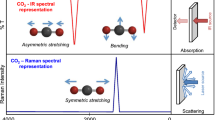Abstract
Spectrum analyzers are ubiquitous in laboratory work concerning one dimensional signals. This is because linear operators are best examined in the frequency domain. Linear operators, such as linear filters, DCT coders, line shufflers, etc., dominate also the video systems scenario. Their frequency domain study is as appropriate and informative as it is in the case of their one-dimensional counterparts. This paper considers the problems associated with the introduction of two well-known spectral estimation techniques, the periodogram and AR estimates, to the context of television signals. The potential for application of spectral estimation to video problems is exemplified by a number of applications related to the fields of enhanced quality television and HDTV. Special attention is paid to the computational aspects, whose effective solution conditions the practical applicability of the proposed spectral estimation techniques.
Similar content being viewed by others
References
B. Wendland and H. Schröder, “On Picture Quality of Some Television Signal Processing Techniques,” SMPTE Journal, 1984, pp. 915–922.
J.O. Drewery, “The Filtering of Luminance and Chrominance Signals to Avoid Cross-Colour in a PAL Colour System,” BBC Res. Dept, Report No. BBC RD 1975/36.
E. Dubois, M.S. Sabri and J.Y. Ouellet, “Three-Dimensional Spectrum and Processing of Digital NTSC Colour Signals,”SMPTE Journal, vol. 91, 1982, pp. 372–378.
Clarke,Transform Coding of Images, New York: Academic Press, 1985.
J.W. Woods and S.D. O'Neil, “Sub-band Coding of Images,”IEEE Transactions on Acoustics, Speech and Signal Processing, vol. 34, 1986, pp. 1278–1288.
P.J. Burt and E.H. Adelson, “The Laplacian Pyramid as a Compact Image Code,”IEEE Transactions and Communications, vol. COM-31, 1983, pp. 532–540.
S. Mallat, “Multifrequency Channel Decomposition of Images and Wavelet Models,”IEEE Transactions on Acoustics, Speech and Signal Processing, vol. ASSP-37, 1989, pp. 2091–2110.
M. Kunt, K. Ikonomopoulos, and M. Kocher, “Second-Generation Image-Coding Techniques,”Proceedings of the IEEE, vol. 73, 1985, pp. 549–574.
J.O. Drewery, “The Zone Plate as a Television Test Pattern,” BBC Res. Dept., Report No. BBC RD 1978/23.
M. Weston, “A Set of Television Varying Test Patterns,” BBC Res. Dept., Report No. BBC RD 1980/9.
T. Fukinuki and Y. Hirano, “The to-and-fro Zone Plate (TFZP) Method Observing Frequency Characteristics in Three Dimensions,”SMPTE Journal, 1986, pp. 899–902.
E. Dubois and W. Schreiber, “Improvements to NTSC by Mulitdimensional Filtering,”SMPTE Journal, 1988, pp. 446–463.
M. Weston, “Fixed Adaptive, and Motion Compensated Interpolation of Interlaced TV Pictures,” inSignal Processing for HDTV, L. Chiariglione ed., Amsterdam: North-Holland, 1989.
J.L. Horrer, ed.,Optical Signal Processing, New York: Academic Press, 1987.
S.M. Kay,Modern Spectral Estimation, Englewood Cliffs, NJ: Prentice-Hall, 1987.
S.L. Marple, Jr.,Digital Spectral Analysis with Applications, Englewood Cliffs, NJ: Prentice-Hall, 1987.
CCIR Recommendation 601, “Encoding Parameters of Digital Television for Studios,” inCCIR Recommendations and Reports, ITU, XI, Geneva, Switzerland, 1982.
E. Dubois, “The Sampling and Reconstruction of Time Varying Imagery with Applications in Video Systems,”Proceedings of the IEEE, vol. 73, 1985, pp. 502–522.
J. Makhoul, “Linear Prediction: A Tutorial Review”,Proceedings of the IEEE, vol. 63, 1975, pp. 561–578.
M.E. Ekstrom and J.W. Woods, “Two-Dimensional Spectral Factorization with Applications in Recursive Digital Filtering,”IEEE Transactions on Acoustics, Speech and Signal Processing, vol. ASSP-24, 1976, pp. 115–128.
T.S. Huang,Image Sequence Analysis, Berlin: Springer-Verlag, 1983.
A.B. Watson and A.J. Ahumada, Jr., “A Look at Motion in the Frequency Domain,” NASA Technical Memorandum 84352, NASA—Ames Research Center, 1983.
L. Cafforio and F. Rocca, “Methods for Measuring Small Displacements of Television Signals,”IEEE Transactions Information Theory, IT-22, 1976, pp. 573–579.
G. Cariolaro, R. Rinaldo, and L. Tomba, “A Bidimensional Model of Line Shuffling,”Image Communication, vol. 2, 1990, pp. 291–304.
D. Dudgeon and R. Merserau,Multidimensional Digital Signal Processing, Englewood Cliffs, NJ: Prentice-Hall, 1984.
L.R. Morris, “Automatic Generation of Time Efficient Digital Signal Processing Software,”IEEE Transactions on Acoustics, Speech and Signal Processing, 1977, pp. 74–79.
M. Wax and T. Kailath, “Efficient Inversion of Toeplitz Matrix,”IEEE Transactions on Acoustics, Speech and Signal Processing, vol. ASSP-31, 1983, pp. 1218–1221.
G. Cortelazzo, G.A. Mian, and R. Rinaldo, “Toeplitz Properties of the Block Matrices Encountered in the Processing of Spatio-Temporal Signals,”IEEE Transactions on Signal Processing, vol. 39, 1991, pp. 1672–1674.
A.E. Yagle, “Analogous of Split Levinson, Schur, and Lattice Algorithms for Three-Dimensional Random Field Estimation Problems,”Journal of Applied Math, to appear.
Y. Wang, H. Krishna, and B. Krishna, “Split Levinson Algorithm Is Weakly Stable,” inProceedings of ICASSP-89, Glasgow 1989, pp. 1215–1218.
C.M. Rader, “An Improved Algorithm for High Speed Autocorrelation with Applications to Spectral Estimation,” IEEE Transactions on Audio and Electroacoustics, vol. AU-18, 1970, pp. 439–441.
R. Rinaldo, G. Cortelazzo, and G.A. Mian, “Techniques for the Efficient Evaluation of Two-Dimensional Auto-Correlation Functions,” to appear on IEEE Transactions on Signal Processing.
Author information
Authors and Affiliations
Additional information
R. Rinaldo is currently at the Department of Electrical and Computer Engineering of the University of California, Berkeley.
Rights and permissions
About this article
Cite this article
Cortelazzo, G., Mian, G.A. & Rinaldo, R. Spectral estimation of video signals. Multidim Syst Sign Process 3, 131–160 (1992). https://doi.org/10.1007/BF01942040
Received:
Revised:
Issue Date:
DOI: https://doi.org/10.1007/BF01942040




